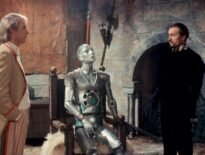I had a discussion with Simon in the comments section a little while ago about comparing Season 24 of the John Nathan-Turner era to Series 11 and 12 of the Chibnall era. He made the solid point that while Season 24 had absolutely nothing going for it, the Chibnall era had better cinematography, direction, and most importantly, no Mel.
Now, I totally disagree on direction– a director works with what they have, and there’s a long list of Classic Who directors that were excellent, and are every bit as good as the new era bunch, no question.
As for Mel, I’d quickly counter: Ryan. But it’s really close.
But as far as cinematography goes, no doubt, hands down, the Chibnall era wins. No contest. Some say it’s the best and most glorious cinematography since the new era started in 2005. (I’d say go rewatch the beginning of Tooth and Claw and get back to me.) But all that got me thinking about how our beloved show has been presented to us over the decades and how much has been made of the cinematography angle.
It raised the question as to what exactly is that worth? Does the breathtaking view of Norway at the start of It Takes You Away compensate for the rubbish frog at the end? Many would say no.
When it comes to the most loved Doctor Who stories, what elements do we remember most fondly? I’m looking back, thinking about some classic Who highlights, and it’s the alien designs which spring to mind first. The Vocs and super-vocs from Robots of Death, the Zygons, Draconians, the Mondasian Cybermen from Tenth Planet — still the scariest of all Cyber designs, some might say.

I’m not sure exactly how much the quarry scenes would have benefited from HD cameras.
The classic series camera work bounced back and forth from video to film, depending on the story. Some might look down their nose at the video look, but many say that look was part of the charm of the classic series.
Much is made of “the wobbly sets” of the era, as it’s become a bit of an in-joke to knock the old incarnation of the show. Although in many interviews, the actors and production people of the time stand by the sets. One gets the feeling that the wobbly bits were the exception, not the rule. Indeed, some of those “wobbly” sets were miraculous in both construction and design — even more impressive with the imposed financial limitations.
Of course, presentation of the show can’t go without mentioning the special effects. Most people understand that Classic Doctor Who had no budget to speak of, but they did the best they could. Still, you get the hecklers. It’s inevitable. Sadly, they were what they were; some worse than others (I’m looking at you, Vardans!).
And I’m not even going near the dinosaur puppets.
In fact, not that long ago, I was listening to a podcast where the host had just started watching the new era, early Christopher Eccleston… and was busting on the “lame effects”, saying they looked like cheap video game visuals. So it’s come to that!
Perhaps it comes down to the equivalent of many sci-fi fans being mesmerized by pretty, shiny objects.
When Star Wars burst onto the scene, it certainly wasn’t the acting or the story that blew people away and started a craze. It was the amazing special effects, John Williams’ brilliant score, and the presence of Darth Vader. George Lucas simply had the advantage of brilliant, cutting edge effects of the day.
In the subsequent decades, with the prequels and sequels, he no longer had any advantage, save Williams’ score and fan loyalty. There’s a lot less love given to the latter trilogies.
But I think sometimes we’re unduly swayed by the pretty-pretty.

Make no mistake, presentation is important, but I think maybe too much emphasis is put on cinematography in modern Who. Sure, there were a couple of epic, beautiful shots in The Ghost Monument, but in the end… it was The Ghost Monument.
So, when comparing and evaluating stories, I really can’t recommend a bad story just because it has great cinematography. Although I’d wager that most good stories might just happen to also have decent lighting, cinematography, etc.
Above all else, you need good stories, writing, characters and actors. All else is just frosting on the cake.
And in the debate regarding Season 24 versus the Chibnall era, it’s a wobbly comparison anyway. McCoy’s first season was only four 14 episodes comprising four stories, ranging from stupid, to eye rolling and cringeworthy. I’ve watched the season two, maybe three times over the last 30 years. It was bad, but ultimately harmless.
The Chibnall era has so far contained 22 episodes comprising 21 stories, ranging from good, to eye rollingly bad, all the way to incredibly offensive and insulting. An argument could be made that some parts of the Chibnall era were much worse than what Season 24 force fed the die hard fans.
So you’ve got four stories vs 21. Very uneven contest there. In Series 11, there are more than four stories debatably just as bad as Season 24, but there are four that are arguably better. Same for Series 12. Across the board, there was a lot of bad stories, writing, characters, and even acting.
Let’s just say cinematography was not really a factor, and it’s hard to ignore that Season 24 was really bad, as are huge swaths of the Chibnall era.



